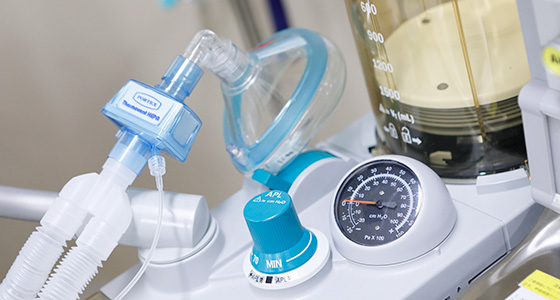- HOME
- Department
- Anesthesiology
Anesthesiology

(1) Overview
We, Anesthesiology, are responsible for the anesthesia care for 4,500* annually.
We are accredited as a certified anesthesia supervising hospital by the Japanese Society of Anesthesiologists. We aim to provide safe and high quality of anesthesia care by the anesthesiologists certified by the Japanese Society of Anesthesiologists.
Anesthesia is largely divided into general anesthesia and local anesthesia. The method is to be determined based on the patient’s condition, nature and site of the disease, surgical method, and time required for the surgery. Spinal anesthesia or epidural anesthesia is commonly chosen for short time surgery of the lower abdomen or lower libs (lower body such as a leg). Recently, cases of general anesthesia combined with epidural anesthesia are getting increased to alleviate pain during and after the surgery.
During anesthesia, anesthesiologists are careful in performing anesthesia safely while checking blood pressure monitor, electrocardiography, and oximeter.
- *The number of surgeries requiring anesthesiologists is 4712 (from April 1, 2024 to March 31, 2025)
(2) Policy
In every surgery, our anesthesiologists will be on the side of a patient from the start to the end of anesthesia.
Every anesthesia practice has risk of developing complication risk. Accordingly, our duty is to protect safety of our patients by paying close attention with checking if there is decline in blood pressure, or change in pulse rate.
(3) Our Strengths
Explanation of General Anesthesia and Examples of the Scenes to Be Used
The anesthesia method includes inhalation anesthesia (tracheal intubation by intubating the tube and mask anesthesia securing the respiratory tract by using the mask) and intravenous anesthesia.
For example, in case of tonsillectomy for an adult patient, general anesthesia by tracheal intubation will be selected. Muscle relaxants to loosen the muscles may be used. In such case, respiratory support or artificial respirator may be used to support the respiration.
In case of surgery requiring general anesthesia, a mask called laryngeal mask are being inserted into the oral cavity may be used to control respiration safely for a long period of time. This will not be selected for tonsillectomy, which is the surgery performed inside of the mouth.
As above, appropriate anesthesia method will be selected depending on the treatment area and the time required for the surgery.
Explanation of Local Anesthesia and Examples of the Cases to Be Used
The local anesthesia includes the topical anesthesia, topical infiltration anesthesia, block anesthesia (spinal anesthesia, epidural anesthesia, and nerve blocker). For example, in case of gastrectomy, both local anesthesia and the general anesthesia will be used. In this case, epidural anesthesia injecting an anesthetic through a catheter from the back is selected as the local anesthesia.
In case of epidural anesthesia, an anesthetic can be injected continuously, after waking up from general anesthesia after gastrectomy. It is, therefore, possible to control pain due to surgical scar after the surgery.
Epidural anesthesia combined with general anesthesia may be selected for abdominal surgery, chest surgery such as lungs, orthopedic surgery such as knee joints, gynecology & obstetrics surgery such as uterus, and urological surgery such as prostate gland in addition to gastrectomy.
Message for Our Patients
We, anesthesiologists have limited opportunity to meet our patients. We make our best efforts to provide safe, reliable, and comfortable surgery for our patients. Please trust us if you need to have the surgery. Should you have any concern, please do not hesitate to ask us.